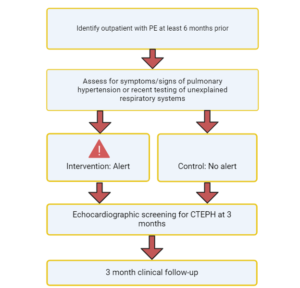CTEPH-Detect is a single-center, randomized controlled trial of an EPIC Best Practice Advisory (BPA) alert-based decision support tool. CTEPH-Detect is set to enroll 400 patients seen in the outpatient setting at Brigham and Women’s Hospital. The first aim of the study is to determine the impact of a BPA, using EPIC on echocardiographic screening for CTEPH in patients with prior pulmonary embolism (PE) and symptoms/signs suggestive of pulmonary hypertension or recent pulmonary testing suggesting unexplained respiratory symptoms. The second aim of the study was to determine the impact of an EPIC BPA on the diagnosis of CTEPH in patients with prior PE and symptoms/signs suggestive of pulmonary hypertension or recent pulmonary testing suggesting unexplained respiratory symptoms.

Subgroup Analysis for the Primary Outcome in a Study of the Effect of Intermediate-Dose vs Standard-Dose Prophylactic Anticoagulation Among Patients With COVID-19 Admitted to the Intensive Care Unit.
Code Aorta is a single-center, retrospective, prospective analysis, and quality improvement study. The study analyzes the data of patients admitted to Brigham and Women’s Hospital with acute aortic syndrome (AAS). The study is set to enroll 1,000 patients either admitted to inpatient service with an AAS or outpatients identified as having a history of an AAS. The primary objective of the study is to determine if improvements in coordination of care and systematic follow up in patients with AAS improve outcomes. The secondary objectives of this study are to determine the natural history of subtypes of AAS and to characterize risk markers that may be useful for prognosis or informing therapeutic decision-making including imaging characteristics, available blood tests, and clinical characteristics.
The Discharge eAlert study is a randomized controlled trial which investigates the impact of a computerized decision support strategy on patients at high risk of venous thromboembolisms (VTE). Discharge eAlert aims to increase the frequency of VTE prophylaxis in high-risk patients. The study aims to determine whether alerting physicians about the importance of VTE prophylaxis prior to the time of planned hospital discharge will lower the incidence of outpatient VTE. The two strategies implemented were devising a risk score that reliably and quickly identified patients of high-risk of VTE and randomizing high-risk patients without prophylaxis into an intervention group or control group.